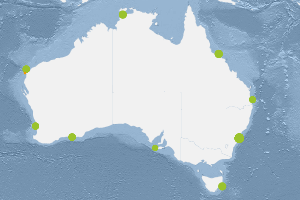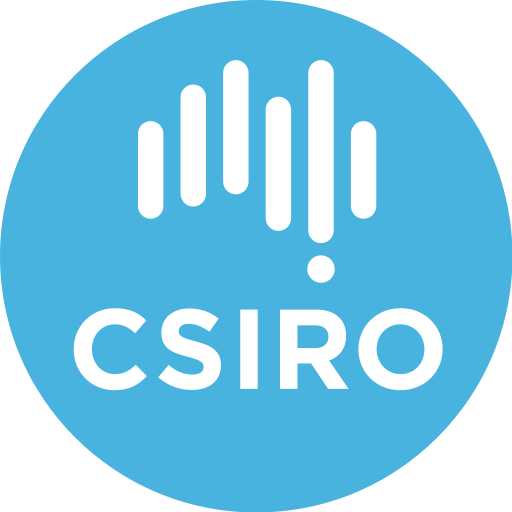Contact for the resource
CSIRO
1046 record(s)
Type of resources
Topics
Keywords
Contact for the resource
Provided by
Years
Formats
Representation types
Update frequencies
Status
draft
-
This dataset contains data collected by the Australian Continuous Plankton Recorder (AusCPR) survey and is funded by IMOS (Ships of Opportunity sub-facility) and CSIRO. The aims of the AusCPR survey are to: * map plankton biodiversity and distribution * develop the first long-term plankton baseline for Australian waters * document plankton changes in response to climate change * provide indices for fisheries management * detect harmful algal blooms * validate satellite remote sensing * initialise and test ecosystem models. The survey conducts repeat tows in the GBR, the East Australian Current and down to the Southern Ocean Time Series Mooring (SOTS). Other routes are conducted on an adhoc nature around Australia. The dataset also contains phytoplankton data from the UTAS / AAD led Southern Ocean CPR (SOCPR) project which is also funded by IMOS. The datasets available in this collection include Phytoplankton Colour Index (an estimate of chlorophyll in the water), phytoplankton abundance, zooplankton abundance and a biomass index from AusCPR and phytoplankton abundance from SOCPR. This data are freely available through the AODN portal: https://portal.aodn.org.au. This data is freely available but please acknowledge all relevant parties, as detailed in acknowledgement section.
-

This dataset comprises the phytoplankton abundance and biovolume estimates as part of a broader sampling program carried out at the Southern Ocean Time Series, a facility within the Integrated Marine Observing System (IMOS). The primary focus is sustained observing of ocean properties and processes important to climate, carbon cycling, and ocean productivity. Regular phytoplankton samples are collected at approximately 14 day intervals (exact intervals and seasonal coverage dependent on deployment length). The moorings are serviced annually, at which time the existing moorings are recovered and new moorings are deployed. Water samples from within the surface mixed-layer are collected at pre-programmed intervals using a Remote Access Sampler, in pairs about 1 hour apart. One sample in each pair is preserved for phytoplankton community composition by microscopy, and the other sample is preserved and used for accompanying chemical analysis of nutrients, total dissolved inorganic carbon (DIC) and alkalinity. Each sample is collected from within the surface mixed-layer at 32 m depth (2010 - 2017) or 5 m depth (2018-current) depending on the design of the mooring surface assembly and instrumentation. Typically a maximum of 24 samples are collected over an annual deployment cycle. The samples collected are analysed for: 1. Community composition / abundance (cells/L) 2. calculated biovolume (um3/L). Protocols for the phytoplankton time-series are described in Eriksen et al (2018), and the annual sample reports for each deployment. Data storage and access is planned to be interoperable with other national and international programs through the IMOS Infrastructure. Station metadata can be found through this resource. Data is available freely via the AODN portal: https://portal.aodn.org.au. As the taxonomic resolution of the data has changed over time, due to continual training, it is important that users refer to the change log tables included in your data download. These will provide information on the validity of the taxa, from what date we have been identifying certain taxa etc. Classification fields may be blank depending on the level to which that taxa has been identified, i.e. if only identified to family, genus and species will be blank.
-
This record contains data collected from the near-water surface sampling site off the Lucinda Jetty, as part of the Lucinda Jetty Coastal Observatory. Sample collection began the 9th of January, 2014. The data can be used for Ocean Colour sensor validation. Parameters measured include the absorption coefficients of the particulate and dissolved components of the water column and the phytoplankton pigment concentration and composition.
-
This record describes the datasets collected from the development of a Gene Tagging Tool for the Regional Tuna Tagging Programme (RTTP) which is managed under the auspices of the Indian Ocean Tuna Commission and genetic tagging studies. The aim is to quantify population structures and migratory dynamics which are currently poorly understood. The use of SNP markers lend themselves easily to routine and inexpensive ($10-$20 per fish) screening methodologies. The stock assessment advice is used to assist in the conservation and optimal economic use of this resource. This record describes the datasets collected or resulting from the outcome of the programme. Acronyms: ANSFAS: -Australia New Zealand Food Authority SNPs: -Single Nucleotide Polymorphisms IOTC: -Indian Ocean Tuna Commission RTTP: -Regional Tuna Tagging Programme FRDC: -Fisheries Research and Development Corporation
-

Coral reef survey of benthic cover, between northern Ningaloo and the Dampier Archipelago. The data include Benthic Cover (%) of benthic life forms on 25m transects, derived from point intercept data taken from transect images. Attributes: COLUMN_NAME COMMENTS YEAR_SAMPLED — Year that site was analysed for habitat cover SITE_ID — Site identifier (Site was photographed and analysed for habitat percent cover) REEF_NAME — Name of reef site is associated with FACIES — Used to describe the part of the reef that the site represents e.g. reef slope, reef flat NO_TAKE — Is the site in a non-fishing zone (based on Marine Park Zoning) or not (Y/N: Y => Non-Fishing Zone, N=>Site is fished) LAT — Site Latitude LON — Site Longitude BROADGROUP — Broadgroup classification of benthic cover SUBGROUP — Subgroup classification of benthic cover PERCENT_COVER — Percent cover of subgroup habitat for the site in the year sampled
-
The Ningaloo Commonwealth Marine Reserve (NCMR) lies offshore and adjacent to the state-managed Ningaloo Marine Park (Figure 1). The reserve extends for ~300 km along the west coast and the depth ranges from 50 to 500 m. The NCMR is zoned IUCN Category II – Recreational Use Zone and no commercial fishing is permitted. However, an increasing number of recreational fishers are choosing to move offshore from the state managed Ningaloo Marine Park into the deeper waters of the NCMR. This is concerning because very little is known about the composition and abundance of demersal fish the habitats and depths encompassed by the Commonwealth reserve. It is also one of the few Commonwealth Marine Reserves readily accessible to recreational fishers. We propose a non-extractive survey to establish baseline composition and abundances of fish in the NCMR, and align this with standardised surveys of fishing effort. The survey will employ Standard Operating Procedures for all mapping and sampling activities, as developed in NESP Project D2. Approximately 200 BARUV drops will be conducted in 2019.
-

Coral reef survey of target fish species and large grazing fish between northern Ningaloo and the Dampier Archipelago. The data include: * Fish UVC database - long transects 100x10m
-

Coral reef underwater visual census (UVC) survey of reef fish species between northern Ningaloo and the Dampier Archipelago. The data include: * Fish UVC database - short transects 25x5m: Fish Counts * Fish families excluding cryptic benthic groups eg gobies. Sharks and rays are included.
-

Reproduction and recruitment underlie the maintenance of biological communities. For most marine organisms the ocean environment provides the potential for widespread dispersal of organisms during various life cycle stages via currents, tides and wind. Within the Kimberley region, key biological communities have a range of reproductive modes. Understanding patterns of larval connectivity is critical to managing the exposure of biological communities to disturbances in space and time. KSN Project 1.1.3 employed genomic tools (microsatellite DNA markers and single nucleotide polymorphisms) and microchemistry to provide the first comprehensive measurements of the distances moved by marine organisms between Kimberley reefs, and how frequently organisms move between the Kimberley and other regions (e.g. offshore shoals, the Pilbara). The research also identified potential barriers to movement. Seven organisms (two hard corals, two seagrasses, a mollusc, two fishes) were chosen as models for exploring connectivity in the Kimberley at both fine and broad scales. Samples for genetic analysis were collected during joint WAMSI/traditional owner field trips to the Dampier Peninsular and Buccaneer Archipelago in Spring and Summer 2014. This metadata record applies to three of the seven species investigated as part of project WAMSI 2 KSN 1.1.3. The data held is Raw SNP genotype. Metadata records associated with other species and lodged by AIMS, WA Museum, Curtin University, Department of Fisheries (WA) and Edith Cowan University can be accessed via Pawsey.
-

This record describes the WAMSI KMRP Project 2.2.8: Knowledge Integration and Management Strategy Evaluation (MSE) Modelling of the Kimberley Region. The project explores the possible and desired futures of the Kimberley region using two computer models, Ecopath with Ecosim (EwE) and ALCES. In this project the future is defined to 2050. EwE was used to characterise the trophic structure, ecosystem attributes and impact of fishing and climate change in the region. ALCES modelled terrestrial land-use and landscape dynamics and interfaced with the marine ecosystem dynamics (EwE) model to generate output on how these ecosystems interact and change over time. The purpose of using these models was to integrate existing and new knowledge about the Kimberley system and to provide an estimation of the likely impacts of different stressors on the land (ALCES) and marine (EwE) environments. This metadata record relates to the input and outputs for EwE and lists only the inputs form ALCES. Refer to the additional metadata description for details on the ALCES component.
